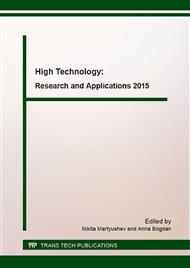[1]
A.V. Korshunov, Influence of dispersion aluminum powders on the regularities of their interaction with nitrogen, Russ. J. Phis . Chem. 85 (2011) 1202-1210.
DOI: 10.1134/s0036024411070156
Google Scholar
[2]
K. Hauffe, Reactions in and on solids, U.S. Atomic Energy Commission, Division of Technical Information (1962).
Google Scholar
[3]
W.H. Hunt, New directions in aluminum-based P/M materials for automotive applications, Inter. J. Powd . Metal. 36 (2000) 50-56.
Google Scholar
[4]
F.V. Beaumont, Aluminum P/M: Past, present and future, Inter. J. Powd. Metal. 6 (2000) 41-44.
Google Scholar
[5]
А.P. Il'in, L.O. Root, and A.V. Mostovshchikov, The Rise of Energy Accumulated in Metal Nanopowders, Techn. Phys. 57 (2012) 1178-1180.
DOI: 10.1134/s1063784212080129
Google Scholar
[6]
A.A. Gromov, U. Teipel, Metal Nanopowders: Production, Characterization, and Energetic Applications, Wiley-VCH, Weinheim, (2014).
DOI: 10.1002/9783527680696
Google Scholar
[7]
N.S. Lidorenko, А.V. Sidyakin, About possibility of a thermal explosion in thin metal powders [in Russian], The Bulletin АS USSR, 202 (1972) 566—569.
Google Scholar
[8]
A.P. Il'in, A.V. Mostovshchikov, and N.A. Timchenko, Phase Formation Sequence in Combustion of Pressed Aluminum Nanopowder in Air Studied by Synchrotron Radiation, Combust. Explo. Shock, 49 (2013) 320–324.
DOI: 10.1134/s0010508213030088
Google Scholar
[9]
A.A. Gromov, L.N. Chukhlomina, Nitride Ceramics: Combustion Synthesis, Properties and Applications, Wiley-VCH, Weinheim, (2014).
Google Scholar
[10]
I. Egorov, V. Esipov, G. Remnev et al. A high-repetition rate pulsed electron accelerator, IEEE Transactions on Dielectrics and Electrical Insulation, 20 (2013) 1334–1339.
DOI: 10.1109/tdei.2013.6571453
Google Scholar
[11]
I.S. Egorov, M.I. Kaikanov, E.I. Lukonin et al. The Astra repetitive-pulse electron accelerator, Instruments and Experimental Techniques, 56 (2013) 568–570.
DOI: 10.1134/s0020441213050035
Google Scholar
[12]
I.S. Egorov, V.S. Esipov, E.I. Lukonin et al. A self-triggering system for a cold-cathode thyratron in a pulse voltage generator, Instruments and Experimental Techniques, 58 (2014) 64–66.
DOI: 10.1134/s0020441215010169
Google Scholar
[13]
A.P. Il'in, A.V. Mostovshchikov, and L.O. Root, Growth of Aluminum Nitride Single Crystals under Thermal Explosion Conditions, Tech. Phys. Lett. 37 (2011) 965–966.
DOI: 10.1134/s1063785011100208
Google Scholar
[14]
A.V. Korshunov, A.P. Il'in, N.I. Radishevskaya, and T.P. Morozova, The kinetics of oxidation of aluminum electroexplosive nanopowders during heating in air, Russ. J. Phys. Chem. A. 84 (2010) 576-1584.
DOI: 10.1134/s0036024410090244
Google Scholar
[15]
J.D. Cox, D.D. Wagman, and V.A. Medvedev, CODATA Key Values for Thermodynamics, Hemisphere Publishing Corp. New York, USA, (1989).
Google Scholar


